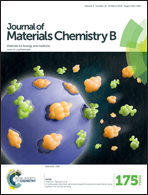A molecularly imprinted nanocavity-based fluorescence polarization assay platform for cortisol sensing†
Abstract
We prepared core–shell-type molecularly imprinted polymer particles (MIP-NPs) for cortisol using cortisol-21-monomethacrylate as a template molecule, itaconic acid as an additional functional monomer, styrene as a comonomer and divinylbenzene as a crosslinker, and established a fluorescence polarization-based sensing nano-platform for the competitive binding assay of cortisol using dansyl-labeled cortisol (dansyl-cortisol). Before the preparation of MIP-NPs, the binding behavior of bulk MIPs prepared by conventional radical polymerization was preliminarily characterized. NIPs prepared with methacrylic acid instead of cortisol-21-monomethacrylate showed less binding activity than the MIPs, revealing that the molecular imprinting process enhanced the affinity toward cortisol. Since the imprinting effect was confirmed in this system, the fluorescence polarization-based sensing nano-platform for cortisol was constructed using MIP-NPs with dansyl-cortisol, where the binding event of cortisol was transduced into the fluorescence anisotropy change of dansyl-cortisol from the bound-state to the free-state, on the basis of the concentration-dependent competitive replacement of dansyl-cortisol by cortisol added on MIP-NPs. The complex of MIP-NPs with dansyl-cortisol was more effectively formed than that of the reference polymer particles (R-MIP-NPs) prepared without itaconic acid, suggesting that the itaconic acid and cortisol-21-monomethacrylate-derived methacrylic acid residues can work cooperatively. Highly sensitive cortisol detection was achieved by the proposed molecularly imprinted nanocavity-based fluorescence polarization assay for cortisol sensing with dansyl-cortisol, and the apparent limit of detection was estimated to be ca. 80 nM.


 Please wait while we load your content...
Please wait while we load your content...